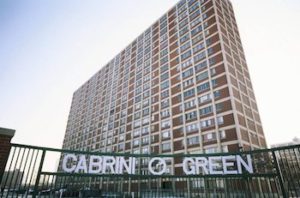
*The Cabrini Green Homes were established on this date in 1942. They were a Chicago Housing Authority (CHA) public housing project on the Near North Side of Chicago, Illinois.
The Frances Cabrini Rowhouses and Extensions were south of Division Street, bordered by Larrabee Street to the west, Orleans Street to the east, Chicago Avenue to the south, and William Green Homes to the northwest. Included as part of the 20th-century American urban renewal program, Cabrini–Green was composed of 10 sections built over 20 years: the Frances Cabrini Rowhouses (586 units in 1942), Cabrini Extension North and Cabrini Extension South (1,925 units in 1957), and the William Green Homes (1,096 units in 1962).
The area witnessed major redevelopment due to its proximity to downtown, resulting in a combination of upscale high-rises and townhouses. Some units were CHA-owned, creating a mixed-income neighborhood. The construction reflected the "urban renewal" approach to city planning in the United States during the mid-20th century. The extension buildings were known as the "reds" due to their red brick exteriors, while the Green Homes, with reinforced concrete exteriors, were referred to as the "whites." Many of the high-rise buildings originally had exterior porches. According to the CHA, the early residents of the Cabrini row houses were Italian. By 1962, most residents in the completed complex were Black.
A timeline for Cabrini Green Homes' story is as follows:
In 1942: Frances Cabrini Homes (two-story rowhouses), with 586 units in 54 buildings. Initial regulations stipulate that 75% of the residents are white and 25% are black. (Named for Saint Frances Cabrini, an Italian American nun who served the poor and was the first American to be canonized.)
In 1957, Cabrini Homes Extension (red brick mid- and high-rises) was completed with 1,925 units in 15 buildings. In 1962, William Green Homes (1,096 units north of Division Street) were completed. (Named for William Green, longtime American Federation of Labor president.
In 1966: Gautreaux et al. vs. Chicago Housing Authority, a lawsuit alleging that Chicago's public housing program was conceived and executed racially racial segregation within neighborhoods. CHA was found liable in 1969, and a consent decree with HUD was entered in 1981.
In 1974, the television sitcom Good Times, presumably set in the Cabrini–Green projects (though the projects were never referred to as "Cabrini-Green" on camera) and featuring video of the complex in the opening and closing credits, debuted on CBS. It ran for six seasons, concluding on August 1, 1979.
From March 26 – April 19, 1981: Chicago mayor Jane Byrne moves into Cabrini–Green to prove a point regarding Chicago's high crime rate. Considered a publicity stunt, she stayed three weeks.
In 1992, Candyman is released, the story taking place at the housing project. In 1994, Chicago received one of the first HOPE VI (Housing Opportunities for People Everywhere) grants to redevelop Cabrini–Green as a mixed-income neighborhood.
On September 27, 1995, the demolition of Cabrini Green began.
Chicago has had several tarnished public housing projects. They include the Robert Taylor Homes and Stateway Gardens on the South Side, Rockwell Gardens, and the Henry Horner Homes. Cabrini–Green's name and problems were the most publicized, especially beyond Chicago. Cabrini–Green often gained press coverage for its chaotic New Year's Eve celebrations when gang members fired guns into the air, causing police to block off nearby streets yearly. Several infamous incidents contributed to the reputation of Cabrini–Green.
Cabrini–Green was home to 15,000 people at its peak, mostly living in mid- and high-rise apartment buildings. Crime and neglect created hostile living conditions for many residents, and "Cabrini–Green" became a metonym for problems associated with public housing in the United States. In 1995, CHA began tearing down dilapidated mid- and high-rise buildings. One hundred and fifty of the dilapidated Frances Cabrini Rowhomes (south of Oak Street, north of Chicago Avenue, west of Hudson Avenue, and east of Cambridge Street) have been renovated and remain inhabited.
As of May 3, 2011, all the high-rise buildings were demolished. Today, only the original two-story rowhouses remain.